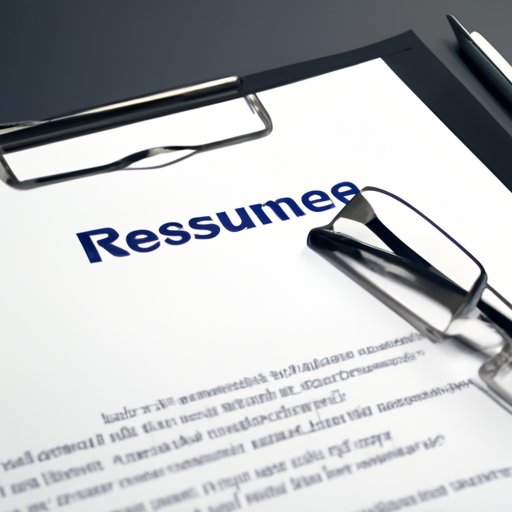Introduction
When it comes to job searching, one of the most important tools in your arsenal is your resume. A well-crafted and professional resume can make all the difference in helping you land the job you want. In this article, we will provide a step-by-step guide for creating an effective resume, offer tips for avoiding common pitfalls, emphasize the importance of customization, highlight the power of keywords, and offer a unique perspective to make your resume standout.
Step-by-step guide for creating a resume
The basic structure of a resume typically includes the following sections:
- Contact information
- Professional summary
- Work experience
- Education
- Skills
Here is a step-by-step guide for each section:
Contact information
Make sure to include your full name, email address, and phone number. LinkedIn or other social media profile URLs can also be included if they are relevant and professional.
Professional summary
This section provides an overview of your experience, skills, and career goals. It should be concise and highlight your strengths and achievements. Consider using bullet points to make it easier to read.
Work experience
Chronological order is the easiest and most common format for presenting work experience. For each job, include the job title, the name of the company, the dates of employment, and a brief description of your responsibilities and accomplishments. Use action verbs to start each bullet point. Quantify your achievements whenever possible (e.g. “increased sales by 20%”). Focus on experience that is relevant to the job you are applying for.
Education
List your highest degree first, followed by any additional degrees. Include the name of the institution, the degree earned, and the dates attended. Also, list any relevant coursework, honors, or awards.
Skills
List any relevant skills or certifications that you possess, such as computer skills, language proficiency, or specialized training. These should be tailored to the specific requirements of the job you are applying for.
Remember, it is important to proofread and edit your resume for errors and clarity.
Address common mistakes
Some of the most common mistakes that job seekers make on their resumes include:
- Spelling and grammar errors
- Lack of specificity or detail
- Irrelevant information
- Using outdated language or terminology
To overcome these mistakes and make the most of your resume:
- Proofread your resume carefully and ask a friend or mentor to review it as well
- Be specific about your responsibilities and accomplishments in each job you’ve held
- Focus on information that is relevant to the job you are applying for
- Use up-to-date language and terminology in your industry
Emphasize the importance of customization
It is essential to customize your resume for each job application. This means tailoring your experience, skills, and achievements to the specific requirements of the job. To do this:
- Research the company and the job description to better understand the employer’s needs
- Highlight your relevant skills and experiences that match the job requirements
- Focus on specific accomplishments that demonstrate your qualifications
Highlight the power of keywords
Many companies use automated resume screening systems to identify qualified candidates. To get past these screening systems, it is important to use keywords that match the job description. To do this:
- Identify relevant keywords by carefully reading the job description
- Incorporate keywords throughout your resume in a natural and meaningful way
- Avoid overusing keywords, which can be seen as “keyword stuffing” and harm your chances
Offer a unique perspective
To make your resume stand out, consider trying a unique approach such as:
- Using a narrative format to tell your story and highlight your accomplishments
- Adding graphics or visuals to draw attention to your resume
Here are some real-life examples of one-of-a-kind resume formats that have brought success:
- A graphic designer using a “comic book” style resume to showcase their creativity and storytelling ability
- A marketing professional using an infographic-style resume to highlight their visual design skills and statistical data analysis
- A recent college graduate using a one-page “video resume” to demonstrate their personality and communication skills
Conclusion
To summarize, creating an effective resume requires careful attention to detail, customization, and a unique approach to make it stand out. By avoiding common mistakes, focusing on relevant experience and skills, and using powerful keywords, you can increase your chances of getting hired. Therefore, take the time to proofread and edit your resume, tailor it to each job application, and be creative and authentic in showcasing your strengths and accomplishments.
